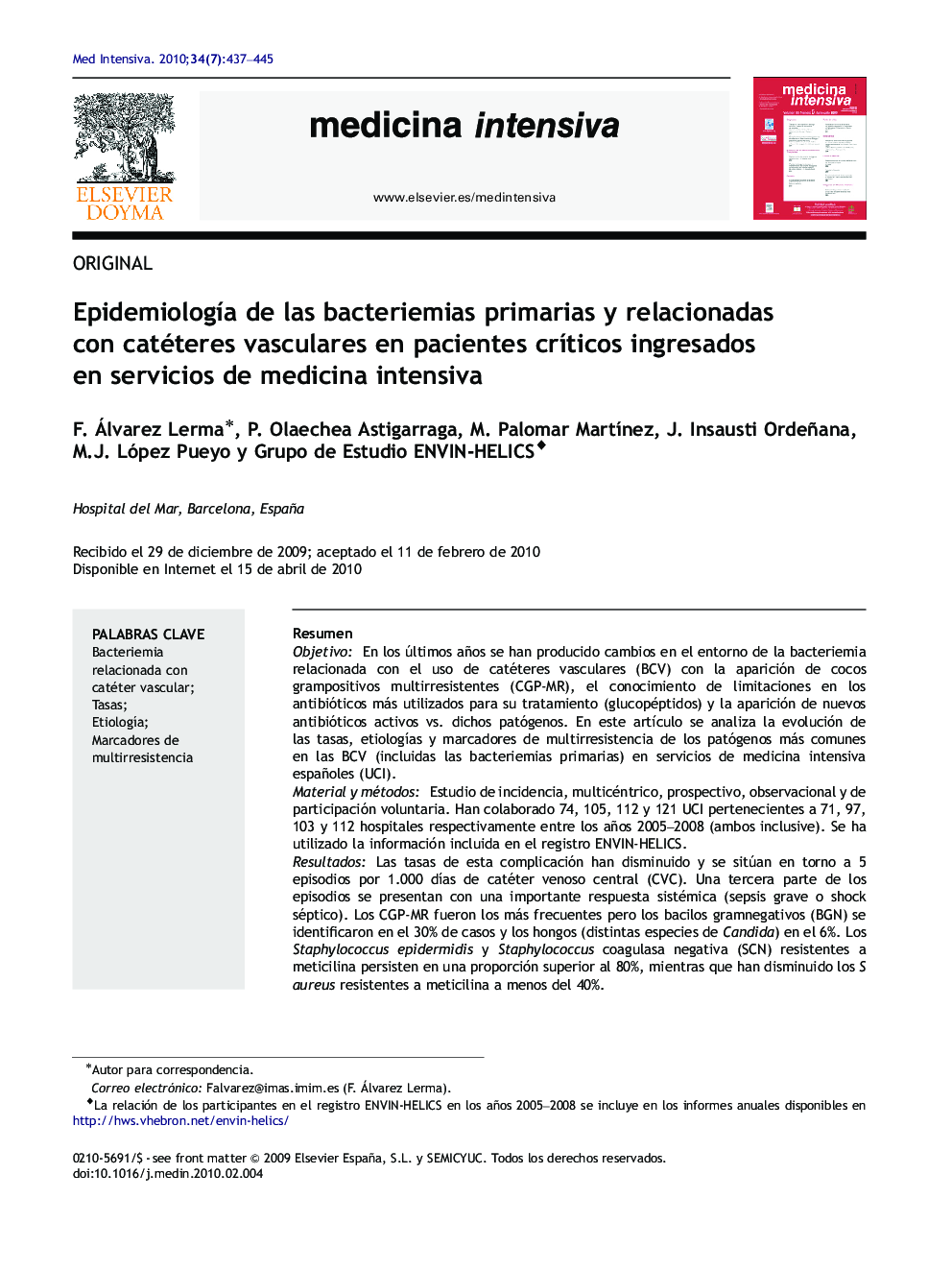| Article ID | Journal | Published Year | Pages | File Type |
|---|---|---|---|---|
| 3113585 | Medicina Intensiva | 2010 | 9 Pages |
ResumenObjetivoEn los últimos años se han producido cambios en el entorno de la bacteriemia relacionada con el uso de catéteres vasculares (BCV) con la aparición de cocos grampositivos multirresistentes (CGP-MR), el conocimiento de limitaciones en los antibióticos más utilizados para su tratamiento (glucopéptidos) y la aparición de nuevos antibióticos activos vs. dichos patógenos. En este artículo se analiza la evolución de las tasas, etiologías y marcadores de multirresistencia de los patógenos más comunesen las BCV (incluidas las bacteriemias primarias) en servicios de medicina intensiva españoles (UCI).Material y métodosEstudio de incidencia, multicéntrico, prospectivo, observacional y de participación voluntaria. Han colaborado 74, 105, 112 y 121 UCI pertenecientes a 71, 97, 103 y 112 hospitales respectivamente entre los años 2005–2008 (ambos inclusive). Se ha utilizado la información incluida en el registro ENVIN-HELICS.ResultadosLas tasas de esta complicación han disminuido y se sitúan en torno a 5 episodios por 1.000 días de catéter venoso central (CVC). Una tercera parte de los episodios se presentan con una importante respuesta sistémica (sepsis grave o shock séptico). Los CGP-MR fueron los más frecuentes pero los bacilos gramnegativos (BGN) se identificaron en el 30% de casos y los hongos (distintas especies de Candida) en el 6%. Los Staphylococcus epidermidis y Staphylococcus coagulasa negativa (SCN) resistentes a meticilina persisten en una proporción superior al 80%, mientras que han disminuido los S aureus resistentes a meticilina a menos del 40%.ConclusionesEl tratamiento empírico en situaciones de extrema gravedad se considera la cobertura de los patógenos más frecuentes como son los CGP-MR y los BGN y en situaciones especiales los hongos.
ObjectiveIn recent years, changes have occurred in the setting of bacteriemia related with the use of vascular catheters (BVC) and with the appearance of multiresistant gram positive cocci (MR-GPC), knowledge of the limitations regarding the antibiotics used most for their treatment (glycopeptides) and the appearance of new antibiotics active against these pathogens. This article analyzes the evolution of the rates, etiologies and markers of multiresistance of the most common pathogens in the BVC (including the primary bacteriemias) in the Spanish Intensive Medicine Departments (ICU).Material and methodsA multicenter, prospective, observational study of incidence, with voluntary participation, was conducted. A total of 74, 105, 112 and 121 ICUs belonging to 71, 97, 103 and 112 hospitals, respectively, collaborated including the years 2005–2008. The information included in the ENVIN-HELICS registry was used.ResultsThe rates of this complication have decreased and are now at about 5 episodes per 1,000 days of central venous catheter (CVC). One third of the episodes occur with significant systemic response (severe sepsis or septic shock). The MR-GPC were the most frequent, however Gram-negative bacilli (GNB) were identified in 30% of the cases and fungi (different species of Candida) in 6%. Staphylococcus epidermidis and coagulase‐negative, methicillin‐resistant staphylococci (CNS) persist in a proportion greater than 80%, while methicillin-resistance S. aureus have decreased to less than 40%.ConclusionsThe empirical treatment in situations of extreme seriousness should consider coverage of the most frequent pathogens such as the MR-GPC and GNB and in special conditions, the fungi.
